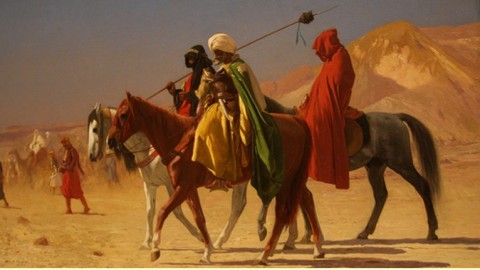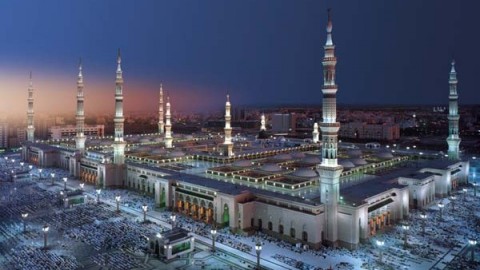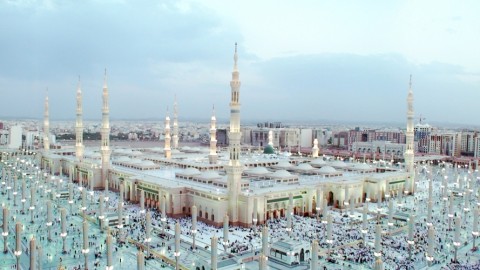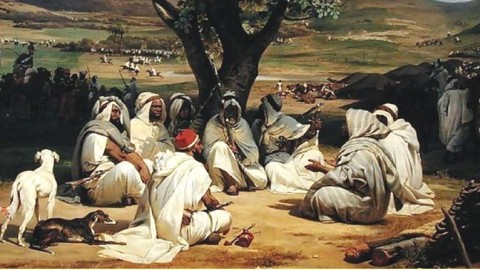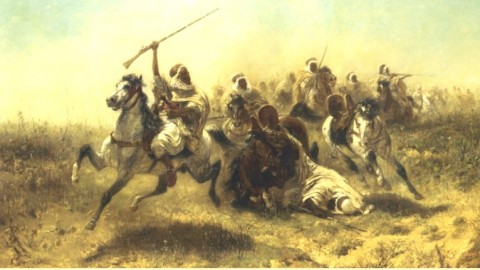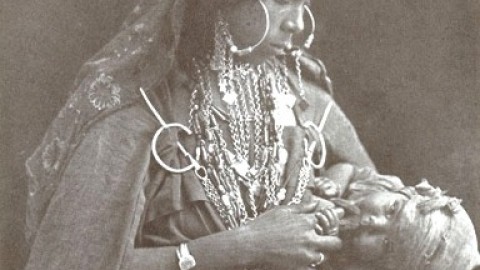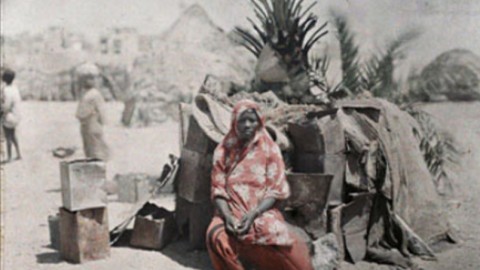In his work, Islam’s Black Legacy: Some Leading Figures (1993), Mohammed Abu-Bakr includes among 62 leading Black figures of Islam the Prophet Muhammad himself.1 Abu-Bakr rightly notes:
According to Muslim tradition, Prophet Muhammad descended in a straight line from Ishmael’s second son Kedar (Arabic: Qaidar), whose name in Hebrew signifies ‘black’…From the sons of Kedar inhabiting the northern Arabian desert, sprang the noblest tribe in Arabia, the Koreish (Quraish), the tribe from which Prophet Muhammad descended. 2
As we have also discussed above, the Arabian Qedar were a black tribe akin to the equally black Nabateans, and these two were in someway related to the Quraish, the black tribe par excellence of ancient Makka.
As Robert F. Spencer remarks: “It is said that the Quraish explained their short stature and dark skin by the fact that they always carefully adhered to endogamy.” 3
al-Jahiz (d. 869), the important Afro-Iraqi scholar of ninth century Baghdad, noted in his Kitab Fakhr al-Sudan ala al-biyadan (The Boast of the Blacks over the Whites):
The ten lordly sons of Abd al-Mutalib were deep black (dalham) in colour and big/tall (dukhm).
When Amir b. al-Tufayl saw them circumambulating (the Kaaba) like dark camels, he said, “With such men as these is the custody of the Kaaba preserved.”
Abd Allah ibn Abbas was very black and tall. Those of Abu Talibs’s family, who are the most noble of men, are dark skinned, black and tall (sud).”
This report is important for our discussion, not only because Abd al-Mutalib and his ten black sons were pure Arabs, but also because they are also the family of the Prophet, Abd al-Mutalib being his paternal grandfather. 5
The Syrian scholar and historian al-Dhahabī (d. 1348) too reported that Abd Allah ibn Abbas, Prophet Muhammad’s first cousin, and his son, Alī ibn AbdAllah, were “very dark-skinned.”6
Alī ibn Abu Talib, first cousin of the Prophet and future fourth caliph, is described by al-Suyuti and others as “husky, bald…pot-bellied, large-bearded…and jet-black (shadīd al-udma).” 7
Ali’s son, Abu Jaffa , according to Bin Sad’s (d. 845), described Ali thusly: “He was a black-skinned man with big, heavy eyes, pot-bellied, bald, and kind of short.” 8
This convergence of blackness, nobility and Quraishī ethnicity is further demonstrated in these lines attributed to the seventh century CE Quraishī poet, al-Fadl ibn al-Abbas, called al-Akhdar al-Lahabi “The Flaming Black”.
Al-Fadl is the Prophet Prophet Muhammad’s first cousin and he said: “I am the black skinned one (al-Akhdar). I am well-known. My complexion is black. I am from the noble house of the Arabs.” 9
Ibn Manzour (d. 1311) notes the opinion that al-ahkdar here means aswad al-jilda, ‘Blackskinned’, and signifies that al-Fadl is from the pure Arabs, “because the color of most of the Arabs is dark (al-udma).” 10
Similarly Ibn Berry (d. 1193) said also: “He (al-Fadl) means by this that his genealogy is pure and that he is a pure Arab (arabi mahd ) because Arabs describe their color as black (al-aswad).” 11
Thus, al-Fadl’s blackness (akhdar) is the visual mark of his pure, Quraishī background, being born of a pure Arab mother and father.
The Quraish consisted of several sub-clans.
Abd al-Mutalib and his descendents, including Prophet Muhammad, belonged to the Banu Hashim.
Henry Lammens takes notice of “les Haśhimites, famille où dominait le sang nègre” (“the Hashimites, the family where Black blood dominated”).12
Lammens remarks that they are généralement qualifies de آدم = couleur foncée” (“generally described as adam =dark colored”).
But the Banu Hashim were not the only sub-clans noted for their blackness.
The Banu Zuhra, the tribe from which the prophet’s mother, Amina bint Wahab, hailed, was likewise noted for its blackness.
See for example the famous Saad ibn Abī Waqqās (d.ca. 646), cousin of Amina and uncle of Prophet Muhammad. He is described as very dark, tall and flat-nosed.13
Prophet Muhammad, it should be noted, was quite proud of his uncle Saad whose military contributions we shall discuss below. We are told that once Prophet Muhammad was sitting with some of his companions and Saad walked by. The prophet stopped and taunted: “That’s my uncle. Let any man show me his uncle.”14
This blackness of the Quraish tribe is not insignificant to the religious history of Islam. The Quraish were the custodians of the cult of the Kaaba in pre-Quranic Makka and at religious ceremonies they would declare nahnu ahlu Allah (“We are the People of Allah”) and throughout Arabia they were known as ahlu Allah, the People of Allah.15
In other words, the black tribe par excellence was also the Allah-tribe par excellence and custodians of the cult of the Black Stone. Nevertheless, or rather as a consequence, Prophet Muhammad’s greatest struggle was with his own kinsmen, this black, Allah-venerating Quraish tribe.
In the end, however, it would be the black Quraish that became the foundation of Islam in it’s inception, at least in the short term.
Not only were the Sunni caliphs drawn from them, but the Shiite Imams, descendents of the black Alī ibn Abu Talib, were likewise black Quraishi Arabs.16
One would thus expect the Quraishī prophet Prophet Muhammad to be black too, especially since he reportedly claimed to be a pure Arab for the house of Hashim 17:…….this would make him very black-skinned like the pure Arabs from that tribe.
The Prophet Muhammad’s pedigree actually demands this as his whole immediate family tree were pure, black-skinned Quraishī Arabs.
I quote again Al-Jahiz important note in his Fakhr al-Sudan ala al-biyadan:
قالوا و كان واد عبد المصلب اعشرة السادة دلما ضخما نظر اليهم علمر بن الطفيل يطوفون كانهم جمال جون فقال؛ بهولأْ تمنع السدانه و كان عبد الله بن عباس ادام صحما ولد اب طالب اشرف الخلق و هم سود و ادم و دلم
Abd al Mutalib (d. 578) was the prophet’s grandfather and Abd Allah, one of his ten ‘deep black’ sons, was Prophet Muhammad’s biological father.
Another deep black son, al-Abbas, was father to the above mentioned Abd Allah ibn Abbas, described as black, and al-Fadl ibn al-Abbas, whose blackness was legendary.
These were the uncle and first cousins of Prophet Muhammad.
Abu Talib, another deep black uncle, was father to Alī ibn Abd Allah, another first cousin of the prophet who was described as jet-black. All of these father-son pairs shared this deep blackness, then what about the Abd Allah / Prophet Muhammad pair?
We would expect the same, unless Prophet Muhammad’s mother made a mitigating contribution. But this is not likely. Amina, the prophet’s mother, was an Arab from the Quraishī sub-clan Banu Zuhra, which was a black clan.
Amina’s cousin and Prophet Muhammad’s maternal uncle, Saad ibn Abī Waqqās, also from Banu Zuhra, was very dark, tall and flat-nosed.19
But Prophet Muhammad had more than just Quraishī blackness running through his veins. His great, great grandfather was Abd Manaf who bore with Atika bint Murra al-Sulaymi the prophet’s great grandfather Hashim.
That is to say that the prophet’s great, great grandmother was from the jet-black Banu Sulaym.
Hashim, the great grandfather, bore with Salma bint Amrå al-Khazraji the prophet’s grandfather, Abd al Mutalib.
This means that his paternal great grandmother was from the black Medinese tribe Banu Khazraj.
Abd al-Mutalib stayed within the Quraish, but he bore the prophet’s father Abd Allah with Fatima bint Amrå al-Makhzåmi, from the exceptionally black Makhzum clan.20
Prophet Muhammad’s maternal lineage is also mixed with non-Quraishi black Arab blood. His mother, Amina, is the daughter of Wahb ibn Aibnd Manaf ibn Zuhra whose mother (Amina’s grandmother) is said to ibn a Sulaymi, another Atika bint Al-Awqas.21
The black ibn Sulaymi are thus considered the maternal uncles of the prophet and he is therefore reported to have said: “I am the son of the many Atikas of Sulaym.”22
This all indicates that Prophet Muhammad’s lineage is a mix of Quraishi, Sulaymi, and Khazraji blackness.
We thus have every reason to expect Prophet Muhammad to be black-skinned, and no reason to believe anything else was possible. We in fact find him described as such in Tirmidh’s Shams al-Prophet Muhammadiyyah.
The following is reported on the authority of the famous Companion of the prophet, Anas ibn Malik:
The Messenger of Allah… was of medium stature, neither tall nor short, of a goodly build. His hair was neither curly nor completely straight. He had a dark brown (asmar) complexion and when he walked he leant forward [walking briskly].23
أسمر asmar is a dark brown as evidenced from other formations from the same root24: samar “darkness, night”; al-garra al-samraʾ “the black continent (Africa)”.25
With the pedigree that he had, any other complexion for Prophet Muhammad would be incomprehensible.
Yet, the same Anas ibn Malik who informed us of the dark brown complexion of the Prophet, also informs us thusly:
While we were sitting with the Prophet in the mosque, a man came riding on a camel. He made his camel kneel down in the mosque, tied its foreleg and then said:
“Who amongst you is Prophet Muhammad?” At that time the Prophet was sitting amongst us (his companions) leaning on his arm. We replied, “This white man reclining on his arm.”26
There are several other reports that describe Prophet Muhammad as أبیض abyad ( white).
How can the same man (Anas ibn Malik) describe another (Prophet Muhammad) as both of dark brown complexion and as white?
The problem, it turns out, is not in these texts but in our modern, Western inability to appreciate the pre-modern Arabic color classification system.
We assume that terms such as white, green, blue, and red meant the same to the early Arabs that they do to us today. But as Moroccan scholar Tariq Berry explains in his book, The Unknown Arabs, this is simply not the case:
The term white can be very confusing to those reading about the description of people of the past because, in the past, when Arabs described someone as white, they meant something entirely different from what is meant today. In the past, when the Arabs described someone as white, they meant either that he had a pure, noble, essence or that he had a nice, smooth complexion without any blemishes. They meant he had a black complexion with a light-brownish undertone.27
Berry’s point is confirmed by ibn Manzour.
ibn Manzour affirmed that “When the Arabs say that a person is white, they mean that he has a pure, clean, faultless integrity…They don’t mean that he has white skin…”28
Similarly, al-Dhahabī informs us that :
“When the Arabs say a person is white, they mean he is black with a light-brownish undertone.”29
Particularly important was the observation of the 9th century CE Arabic scholar Thalab, who tells us that :
“The Arabs don’t say that a man is white because of a white complexion. White to the Arabs means that a person is pure, without any faults. If they meant his complexion was white, they said ‘red’ (ahmar).”30
Indeed, as David Goldenberg notes, ‘white أبیض ’ in pre-modern Arabic was about “luminosity, not chromaticity.”31
That is to say, أبیض ( white ) connoted brilliance, not paleness of skin.
The latter was described as ‘red’ أ حمر asmar, which is how non-Arab whites such as Persians and Byzantines were descriibned.32
In other words, what we call white today the early Arabs called red, and what they called white often was what we would today call black!
It is certain that Prophet Muhammad could not have been what we consider white today; he could not have been fair or pale-skinned at all, for a pale-skinned Arab was such an oddity that the prophet could not have claimed be a pure Quraishi Arab.
The seventh century Arab from the tribe of Nakhāʾī, Shurayk al-Qāī, could claim that, because it was such a rare occurrence “a fair-skinned Arab is something inconceivable and unthinkable.”33
So too did al-Dhahabī report that:
“Red, in the language of the people from the Hijaz, means fair-complexioned and this color is rare amongst the Arabs.”34
On the other hand, the Arabs prided themselves on being black, is conscious contrast to the pale-skinned non-Arabs.
Al-Jahiz could still claim in the 9th century:
al-Arab tafkhar bi-sawad al-lawn “The Arabs pride themselves in (their) black color”35
These noble Black Arabs even detested pale skin.
Al-Mubarrad (d. 898), the leading figure in the Basran grammatical tradition, is quoted as saying: “The Arabs used to take pride in their darkness and blackness and they had a distaste for a pale complexion and they used to say that a pale complexion was the complexion of the non-Arabs”.
Part of the reason for this distaste is that the slaves at the time were largely from pale-skinned peoples, such that ahmar “red” came to mean “slave” back then, just as abid “servant/slave” means black today in the now white Muslim world. As Dana Marniche observes:
Anyone familiar with the Arabic writings of the Syrian, Iraqi and Iranian historians up until the 14th century knows that this is also their description of the early ‘pure’ Arab clans of the Arabian peninsula… [i.e. “blacker than the blackest ink – no shred of white on them except their teeth.”]…
The irony of history is that early Arabic-speaking historians and linguists made a distinction between the Arabs in Arabia and the fair-skinned peoples to the north; and contrary to what may ibne fact in our day, in the days of early Islam, those called ‘Arabs’ looked down condescendingly on fair-skinned populations and commonly used the phrase ‘fairskinned as a slave’ when describing individuals in tribes in the peninsula that were pale in complexion…Of course, today due mainly to slavery and conversion of peoples to the ‘Arab’ nationality, the opposite is thought to be true by many in the West.
A red or pale-skinned Prophet Muhammad would thus have been a profound oddity in 7th century Arabia and would have had little chance of success amongst the proud, black Makkans and Medinese.
The Makkan objectors to his message accused of some of everything, but never of being a non-Arab!
There is absolutely no reason to believe he was pale-skinned other than much later representations that coincide with a major demographic change it the Muslim world, a change that brought with it a strong anti-black ideology.36
We thus have every reason to accept the truth of Anas ibn Malik’s description of the prophet as dark brown (asmar) and to conclude that, as his black cousins Alī and al-Fadl resembled their black fathers (his black uncles), he resembled his black father, especially since his mother’s side was black as well.37
Amru ibn Al-Aas was the Arab Commander of the army that Umar ibn Al-Khattab (RAA) sent to conquer Egypt. Amru ibn Al-Aas was black-skinned and he was from the noble Arab tribe of Quraish. Ibn Kathir says in his book Al-Bidaaya Wa Al-Nihaaya: “He (Amru ibn Al-Aas) was black-skinned, tall, and bald. May Allah be content with him.”وكان أسمر، شديد السمرة، طويلا، أصلع رضي الله عنه
Ubada ibn Al-Samit was a pure, noble Arab from his mother’s side of the family and his father’s side of the family. His father and mother were descendants of Saba, who are descendants of Qahtan. Amru ibn Al-Aas (the Arab leader who was sent to conquer Egypt) assigned Ubada ibn Al-Samit to head a group of ten people to meet Muqawqis/Mikakaus (the Greek ruler of Egypt).
Ubada ibn Al-Samit was black-skinned (black meant black then) and he was over seven feet tall. When they sailed to meet Muqawqis and entered his court, Ubada ibn Al-Samit came forward to speak and Muqawqis became afraid of him because of his blackness and he said, “Get this black man away from me and send forward someone else to speak to me!”
The others said, “Verily this black-skinned man is the most superior of us in opinion and knowledge. He is our master and the best amongst us and the preferred above us. We all follow his word and his opinion. The Amir (Commander) gave him command instead of us and he commanded us to obey him.”
Muqawqis then said to the delegation, “How can you be content with this black-skinned person being the most superior of you?! He should be the lowest of you.” The members of the delegation then said, “No way! Verily, even though he is black-skinned, as you can see, he is from amongst the most superior of us in rank and priority and in intelligence, sense and judgement. Black skin is something normal amongst us.”
Maqawqis then said to Ubaida, “Come forward oh black one and speak softly to me. Your blackness frightens me. If you speak too loudly you will make me more afraid.” Ubaida then came forward and said, “I’ve heard what you said and I inform you that amongst my companions that I left behind me in my camp are 1000 men as black as I am and blacker than I am and more shocking in appearance! If you saw them, you would be more afraid of them than you are of me!”
وبعثه عمرو بن العاص في عشرة نفر لمقابلة المقوقس، وكان عبادة بن الصامت أسود اللون، فلما ركبوا السفن إلى المقوقس ودخلوا عليه، تقدم عبادة، فهابه المقوقس لسواده، فقال: نحُّـو عني هذا الأسود، وقدموا غيره يكلمني. فقالوا: إن هذا الأسود أفضلنا رأياً وعلماً، وهو سيدنا وخيرنا، والمقدَّم علينا، وإنا نرجع جميعنا إلى قوله ورأيه، وقد أمّره الأمير دوننا بما أمّره به، وأمرنا ألا نخالف رأيه وقوله. فقال المقوقس للوفد: وكيف رضيتم أن يكون هذا الأسود أفضلكم، وإنما ينبغي أن يكون دونكم؟. قالوا: كلا! إنه وإن كان أسود كما ترى، فإنه من أفضلنا موضعاً وأفضلنا سابقة وعقلاً ورأياً، وليس ينكر السود فينا. فقال المقوقس لعبادة: تقدم يا أسود وكلمني برفق فإني أهاب سوادك، وإن اشتد عليّ كلامك ازددت لك هيبة. فتقدم إليه عبادة فقال: قد سمعت مقالتك، وإن فيمن خلَّفت من أصحابي ألف رجل أسود كلهم مثلي، وأشد سواداً مني وأفظع منظراً، ولو رأيتهم لكنت أهيب لهم مني
When the Muslim soldiers conquered Egypt, Al-Zubair ibn Al-Awwam, the cousin of the Prophet Mohamed and the nephew of Khadija – the first wife of the Prophet Mohamed, was the first to climb over the fortress. Al-Zubair ibn Al-Awwam was described as follows: “He (Al-Zubair ibn Al-Awwam) was thin-bearded, dark-skinned, hairy, and tall.”
كان خفيف اللحية أسمر اللون، كثير الشعر، طويلاً
Mohamed Ibn Maslama also climbed the fortress. Mohamed Ibn Maslama was an Arab from the tribe of Aws, who were from Saba, who were from Qahtan. Al-Dhahabi says in his book Siyar A’laam Al-Nubalaa: “Ibn Younis says that Mohamed Ibn Maslama took part in the conquest of Egypt and that he was amongst those who climbed over the fortress with Al-Zubair.”
قال ابن يونس شهد محمد فتح مصر وكان فيمن طلع الحصن مع الزبير
Al-Dhahabi also says:”Ubada ibn Rufaa’a says that Mohamed ibn Maslama was black-skinned, tall, and huge.”
قال عباية بن رفاعة كان محمد بن مسلمة أسود طويلا عظيما
Miqdad ibn Amru, who lead 1000 of the soldiers, was described as follows:
“Ibn Umar says that Musa ibn Ya’aqoub related from his aunt Karima the daughter of Miqdad that she described her father to them as a tall, black-skinned man with a large belly, a lot of hair on his head, and a beard that was dyed yellow.”
قال ابن عمر : حدثنا موسى بن يعقوب ، عن عمته كريمة بنت المقداد أنها وصفت أباها لهم فقالت : كان رجلاً طوالاً آدم أبطن كثير شعر الرأس يصفر لحيته
This should give you an idea of what the Arabs who conquered Egypt in the 7th century looked like.
1 Abu-Bakr, Islam’s Black Legacy, Chapter 1. Ben-Jochannon too accepted that Muhammad was “in the family of the Black Race”. African Origins, 237.
2 Abu-Bakr, Islam’s Black Legacy, 1.
3 Robert F. Spencer, “The Arabian Matriarchate: An Old Controversy,” Southwestern Journal of Anthropology 8 (Winter, 1952) 488.
4 Al-JaÈií, Fakhr al-sådan ala al-bidan, in Risa”il Al-JaÈií, 4 vols. (1964/1384) I:209.
5 See below.
6 al-Dhahabī, Siyar, V:253
7 Al-Suyåãī, Tārikh al-khulafā (Cairo: Dar al-Fikr al-Arabi, 1975) 186. On shadīd al-udma as ‘jet- black’ see Berry, Unknown, 54.
8 Ibn Sad, al-Tabaqāt al-kubrā (Beirut: Dar Sādir) 8:25. On Ali as short and dark brown see Henry Stubbe, An Account of the Rise and Progress of Muhammadanism (1911) XX; I.M.N. al-Jubouri, History of Islamic Philosophy – With View of Greek Philosophy and
Early History of Islam (2004), 155; Philip K Hitti, History of the Arabs, 10th edition (London: Macmillan Education Ltd, 1970) 183.
9 Ibn Manzour, lisan al arab, s.v. اخضر IV:245f.
10 Ibn Manzour, lisan al arab, s.v. اخضر IV:245; خضر
E.W. Lane
, Arabic-English, I: 756 s.v. .
11 Ibn Manzour, lisan al arab, s.v. اخضر IV:245.
12 Études sur le siècle des Omayyades (Beirut: Imprimerie Calholique, 1930) 44.
13 al-Dhahabī, Siyar, 1:97.
14 Abd al-Rahmān Rāfat al-Bāshā, ‘uwar min Èayāt al-‘aÈābah (Beirut: Mu’ assasat al-Risālah, 1974-75) 287.
15 Uri Rubin, “The Ilāf of Quraish: A Study of såra CVI,” Arabica 31 (1984): 165-188; Margoliouth, Mohammed, 19.
16 Berry, Unknown Arabs, 62-65.
17 He is supposed to have described himself as “Arab of the Arabs, of the purest blood of your land, of the family of the Hashim and of the tribe of Quraish.”Quoted in Chandler, “Ebony and Bronze,” 285.
18 Al-Jahiz, Fakhr al-Sudan ala al-biyadaan, in Risilat al jahiz, 4 vols. (1964/1384) I:209.
19 al-Dhahabi, Siyar, 1:97.
20 On the significance of these matrilateral listings in Prophet Muhammad’s genealogy see Daniel Martin Varisco, “Metaphors and Sacred History: The Genealogy of Prophet Muhammad and the Arab ‘Triibne’,” Anthropological Quarterly 68 (1995): 139-156, esp. 148-150.
21 Iibnn Athīr, al-Nihaya fi ghariibn al-hadith (Cairo, 1385/1965) III:180 s.v. -t-k; Lecker, IBNanu sulaym, 114.
22 Prophet Muhammad ibn. Yusuf al-salihi al-Shami, Subul al-huda wa-‘l-rashad fi sirat khayr al-ibnad (Cairo, 1392/1972) I:384-85; Lecker,
Banu sulaym, 114-115.
23 Al-Tirmidhi, Shamsl al-Prophet Muhammadiyyah, 2.
24 J M. Cowan (ed.), Hans Wehr Arabic-English Dictionary 4th edition (Ithica: Spoken Language Services, Inc., 1994) 500 s.v. .سمر
25 Berry, Unknown Arabs, 49 notes: “When the Arabs of the past said that a person was brown, they meant that he was dark-skinned; close to
black, which is actually a dark shade of brown.”
26 Sahih al-Bukhari vol. 1 no. 63:
27 Berry, Unknown Arabs, 49.
28 ibn Manzour, Lisān al-Arab 7:124.
29 Al-Dhahabi, Siyar alām al-nubalā (Beirut: Risāla Estaibnlishment, 1992) 2:168.
30 ibn Manzour, Lisān al-Arab. 4:210.
31 Goldenberg, Curse of Ham, 93.
32 Goldziher, Muslim Studies, 1:268.
33 ibn Abd Rabibih, al-Iqd al-farīd (Beirut: Dar al-Kutub al-Ilmiya, 1983) 8:140.
34 Al-Dhahabi, Siyar, 2:168.
35 Al-Jahiz, Fakhr al-sudan ala al-biyadaan, 207. See also Goldziher, Muslim Studies, 1:268 who notes that in contrast to the Persians who are described as red or light-skinned (ahmar) the Arabs call themselves black.
36 See below.
37 Chandler, “Ebony and Bronze,” 280: “All of the chronicles that survive intact agree that Ishmael and Prophet Muhammad were of the Black Race…A
careful examination of history reveals that the Prophet Muhammad…was of the Black Race and was black in complexion.”
(Excerpts from Wesley Muhammad, Black Arabia and the African Origin of Islâm – Published in 2009)




